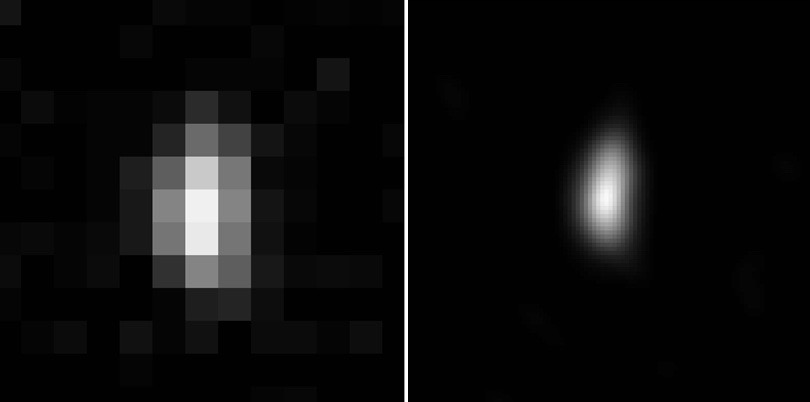NASA's New Horizons Spies Elongated Target Ultima Thule Ahead of Flyby

LAUREL, Md. — After months of staring at only a single pixel of their target, members of NASA's New Horizons mission team now have considerably more to look at. On the eve of its historic flyby, the spacecraft has sent home an image that confirms its distant target, Ultima Thule, has an elongated shape.
"We know it's not round," John Spencer, a New Horizons deputy project scientist, told reporters today (Mon, Dec 31).
Although the image provided a new look at Ultima Thule, it lacks detail. For example, the mission team still cannot tell whether Ultima is a single or binary object. [New Horizons' Historic Flyby of Ultima Thule: Full Coverage]
"We just don't have the details to see it yet," added Spencer, who is based at the Southwest Research Institute (SwRI) in Colorado.
When New Horizons launched in 2006, it had Pluto in its sights. After the July 2015 flyby of that dwarf planet, the spacecraft had enough fuel to visit at least one more object. The Kuiper Belt object (KBO) 2014 MU69, nicknamed Ultima Thule, was selected partly because it was close enough for the spacecraft to visit before it ran out of fuel.
But the new target is so far away and so faint that NASA's Hubble Space Telescope was the only instrument that could see it. As a result, Ultima Thule wasn't even discovered until 2014. By studying how the KBO blocked the light streaming toward Earth fromthree distant stars, astronomers could tease out a little more information about its shape, as well as its path around the sun. But until it came into New Horizons' view, Ultima remained little more than a distant dot hardly different from the stars behind it.
In August 2018, the spacecraft was finally able to capture apixel-wide image of its next target. In the newly released image, which the team received on Sunday (Dec. 30), Ultima is a few pixels wide. A processed version of the raw photo shows the object as an elongated blob.
Get the Space.com Newsletter
Breaking space news, the latest updates on rocket launches, skywatching events and more!
"There's a lot of chatter in the science team room," Spencer said. "We're doing everything we can with so little information."
But the science team members on stage declined to speculate about Ultima's true nature.
"We know that anything we say is going to be wrong tomorrow," Spencer said. The team is expecting the images that will come down in the coming days to be far more intricate, with the most-detailed image being distributed on Thursday (Jan. 3).
That doesn't mean the team isn't giving the new image their full attention.
"I've never seen so many people so excited about two pixels," Stern said, his face advertising his own excitement.
"We've only ever had one pixel before," Spencer added.
Follow Nola Taylor Redd on Twitter @NolaTRedd. Follow uson Twitter@Spacedotcom and on Facebook. Original article on Space.com.
Join our Space Forums to keep talking space on the latest missions, night sky and more! And if you have a news tip, correction or comment, let us know at: community@space.com.

Nola Taylor Tillman is a contributing writer for Space.com. She loves all things space and astronomy-related, and enjoys the opportunity to learn more. She has a Bachelor’s degree in English and Astrophysics from Agnes Scott college and served as an intern at Sky & Telescope magazine. In her free time, she homeschools her four children. Follow her on Twitter at @NolaTRedd









